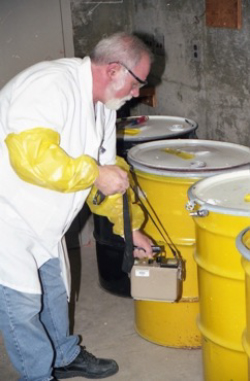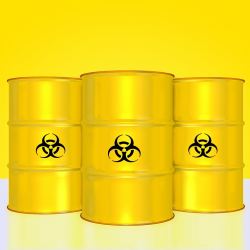Over the years, I’ve generated tens of thousands of cubic feet of radioactive waste, managing the radioactive waste program at a large Midwestern university, and as the Radiation Safety Officer at a mid-sized university in the Northeast. None of this was glowing – in any color – and none of it looked much different from any of the other laboratory, medical, or remediation waste produced in so many places around the world every year.
As a consultant, I oversaw the generation of tens of thousands of cubic feet of additional radioactive waste in a few environmental remediation projects. Some of this waste was stored on-site until it decayed away and could be disposed of as non-radioactive. For example, the short-lived medical isotopes used for nuclear medicine patients decay away, losing its radioactivity in just a few days to months. Same for nuclides used in research. In a university setting, a large chunk of the radioactivity used can also be stored for decay-in-storage. Of all those thousands of cubic feet of radioactive waste I’ve “produced” over the years, most of it has been paper towels, glassware, test tubes, and soil; most about as radioactive as a bunch of bananas (I’ve measured the radioactive potassium in bananas too).
The stuff I generated is like most radioactive waste – we spent a lot of money to dispose of stuff that wasn’t very different (including radioactivity-wise) from the waste I generate at home…without the food scraps, of course.
What does “everybody know” about radioactive waste that’s just out-and-out wrong?
Nuclear waste is going to be dangerously radioactive for millennia.
That’s not really true. Sure, spent reactor fuel is dangerously radioactive when it’s first removed from the reactor, and there are some isotopes of plutonium and americium that remain radioactive for centuries or millennia. But here’s the thing – the stuff that makes that freshly spent fuel so ferociously radioactive is pretty short-lived, which is why it decays and emits radiation so furiously.
In the first six months after a fuel rod is removed from the reactor, the amount of radioactivity contained within spent reactor fuel is reduced to around 10-20% of its initial activity. Within a few decades, the amount of radioactivity has dropped by another factor of 2 or so. Over time, there are fewer highly radioactive short-lived and more less radioactive longer-lived radionuclides, making the spent fuel less radioactive and dangerous. The radioactive danger is largely gone in a century, and within a few millennia, the spent fuel will be little more radioactive than the uranium ore that first came out of the ground). It is true that some radioactivity will remain for ten millennia or more, but nuclides that are this long-lived are not terribly radioactive. Many of them emit primarily alpha radiation, which can’t even escape from the spent fuel to expose those who might encounter it. [1] (https://www.world-nuclear.org/uploadedImages/org/info/Nuclear_Fuel_Cycle...)
We just don’t have enough space to dispose of all the nuclear waste that our reactors produce.
 This “fact” is even less accurate. The problem with disposal isn’t the volume of waste that would be generated. I’ve visited spent fuel storage areas, and they don’t take up all that much room, especially when compared to the footprint of, say, Fresh Kills landfill on Staten Island. [2] Having driven several hundred thousand miles around the US, including multiple coast-to-coast trips, I can personally vouch that the US is not running out of space for landfills.
This “fact” is even less accurate. The problem with disposal isn’t the volume of waste that would be generated. I’ve visited spent fuel storage areas, and they don’t take up all that much room, especially when compared to the footprint of, say, Fresh Kills landfill on Staten Island. [2] Having driven several hundred thousand miles around the US, including multiple coast-to-coast trips, I can personally vouch that the US is not running out of space for landfills.
The problem isn’t even that there are no suitable places for interring radioactive waste. I was involved in evaluating possible radioactive waste disposal sites in Ohio in the 1990s, and there were plenty of locations that met the state’s siting criteria for safe storage. The problem is NIMBY (not in my backyard) – nobody wants to have a radioactive waste repository within many miles of where they live.
In Ohio, there were objections to the volume of truck traffic involved in carrying waste to the site from throughout the Midwest. But even that turns out not to be that big a deal. When I looked into the matter, I found that, on average, there would be only a few trucks coming to the site each week…not enough to disturb anyone’s tranquility. And – in case you’re curious – the radiation dose rates from the site to cars, pedestrians, and neighbors are less than what you’d get from a single x-ray.
And that brings us to the biggie!
We cannot store this material safely for millennia
A half-century ago, French geologists noticed that the mixture of isotopes (specifically U-235 and U-238) in an African uranium ore deposit was different from what was seen anywhere else in the world. Eventually, they concluded that, two billion years ago, this ore deposit had hosted a self-sustaining nuclear chain reaction – it was the “fossil” of a natural nuclear reactor two billion years old. And the same characteristics that let it function as a reactor – being hosted in porous rocks saturated with water – were the last conditions that anybody would choose for a radioactive waste repository. In fact, the criteria for siting a waste repository specifically exclude such rock formations. Despite that, further studies of the natural nuclear reactor in Oklo, Gabon revealed that virtually all fission products had remained in place for more than 2 billion years.
This means that the final big “fact” about nuclear waste is also fallacious – not only can radioactive waste be stored safely for millennia, but nature managed to store it safely for 2 million millennia…without even breaking a sweat.
So…does this mean that I’m going to sprinkle nuclear waste on my breakfast cereal? Well…no – I’m not stupid; I wouldn’t sprinkle bleach on my cereal either. But I’m not going to use nuclear waste “problems” as an excuse to try to shut down nuclear reactors. There are problems involved in nuclear waste disposal – but they’re political and social problems, not scientific or technical ones.
[1] See graphic
[2] Fresh Kills is approximately 3.4 square miles in size and is one of the largest man-made structures in the world.
